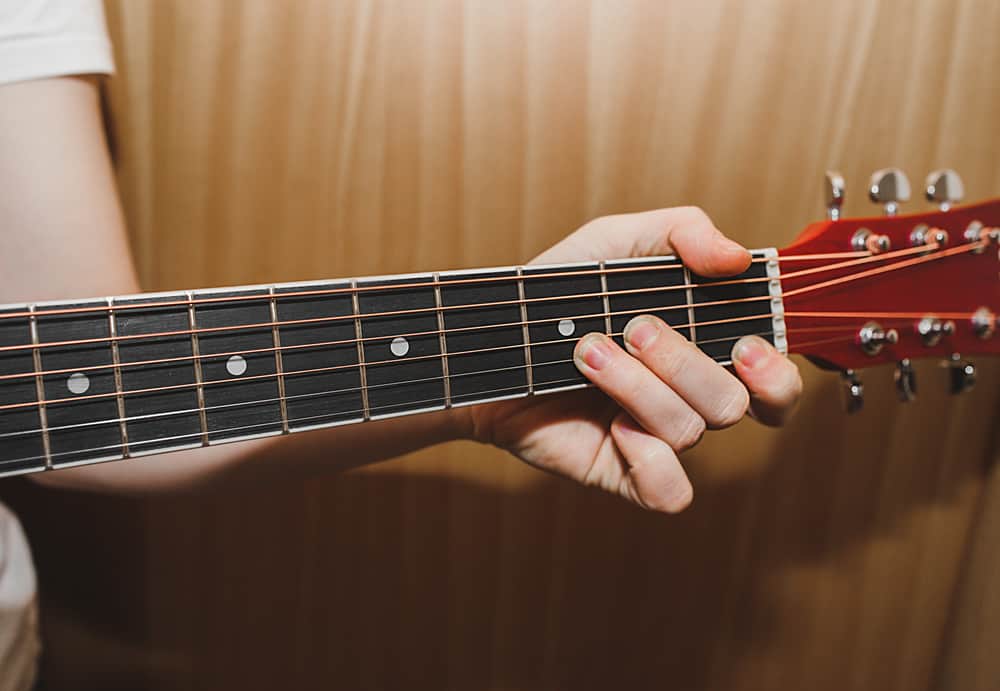
Whether you’re a beginner or seasoned guitarist, you’ve probably heard conflicting opinions about the tension on your guitar neck. Some people say you should change your strings one by one to balance out the tension on the neck. Others say you should change them all at once.
If you’re curious about how much tension a guitar neck sustains when the guitar is tuned, you’ve come to the right place.
Although the tension on a guitar neck depends on the thickness of the strings, an average number is 200 pounds or about 20-80kg of lateral force. Heavier strings exert more tension on the guitar neck and vice versa.
Continue reading to know more about tension on a guitar neck.
Why Should I Worry About the Tension on My Guitar Neck?

When you tune up your guitar, the strings exert tension on the neck, and over time, this can distort the shape of your guitar and even make it unplayable.
As stated earlier, strings with a heavier gauge pull even harder and add more tension to the neck. To compensate for this, all guitars come with a truss rod to prevent the neck from bowing.
Sometimes, your guitar neck still bows due to incorrect placement of the truss rod. Therefore, it may need adjustment. Note that environmental conditions like temperature and humidity can also cause the bowing of the guitar neck.
Calculating Guitar Neck Tension
You can calculate the tension on a guitar neck with a string tension calculator. It’s a tool used to know the exact amount of tension on your guitar strings.
To use an online string tension calculator, you need to enter the scale length of your guitar and the gauge of your strings. After you click calculate, you’ll see how much tension should be placed on your guitar neck.
A general rule of thumb is that your strings should exert low tension to avoid damaging the guitar neck. Higher tension won’t damage it, but it’ll shorten the lifespan of your instrument.
The tension on your guitar neck depends on factors like the gauge of your strings, steel thickness, tuning, and length.
Thick and high tuning strings exert higher tension on the guitar neck to stay in tune. If too much tension is exerted on your guitar neck over extended periods, the neck can warp, and the damage can even extend to your guitar body, especially if your guitar is made of fragile wood.
How To Adjust the Tension on Your Guitar Neck

You may not be able to do this yourself, so it’d be best to walk into your local guitar store and have a technician do it instead.
If you insist on doing it yourself, here are some tips:
- You need a hex wrench to adjust the truss rod nut.
- The truss rod can be found at the end of the neck. The connection between the headstock and the body. It’s an adjustment bolt. You’ll turn it counterclockwise to tighten and clockwise to loosen.
- Turn it until your desired tension is reached.
How Do I Know When I Need To Adjust My Guitar Neck?
First, you need to play the guitar to ensure the strings aren’t buzzing.
Buzzing happens when your strings vibrate against the fret, causing them to make weird sounds. If they are, chances are your guitar neck needs adjusting. You can resolve this issue by raising the saddle height.
Additionally, age can tell you when to adjust your guitar neck. Older guitars tend to have a warped guitar neck which can cause the strings to buzz.
Sometimes, the warped guitar neck leans towards the bridge, causing the lower strings to have too low action.
You can fix this by adjusting your bridge height. If the issue is severe, you may need to adjust your truss rod.
Guitar Adjustment Terms You Should Know

Here are some terms you’ll often come across when looking to adjust your guitar parts.
Relief
The primary function of the truss rod is to adjust the relief of the guitar neck. Relief plays a significant role in the playability of your instrument.
A straight neck with small relief can feel enjoyable, while a large bow, on the other hand, can be frustrating. If your guitar feels harder to play on some areas of the fretboard than others, you should check the relief of your guitar neck.
Action
This is the height of your strings over the fretboard. The higher the strings, the more the action. Action is often subjective to the guitarist’s preference. Some guitarists prefer their strings as close to the frets as possible. Others love higher action.
Intonation
I’m sure you think that the entire guitar gets in tune if you tune your strings. Well, that’s not how it works. Different notes can sound out of tune because of the bridge and truss rod issues.
Takeaway
Most new guitars have the appropriate tension, so you have nothing to fear if you haven’t changed your strings before. Over time, your guitar neck may bow due to external conditions, and you’ll have to adjust things to get it back in good shape. If you can’t do it yourself, you can pay a technician to get it done.
Frequently Asked Questions
Lighter guitar strings require less tension. Hence, they’re easier to play than heavy gauge strings. Your fingers won’t hurt as much when you press down on frets.
The guitar manufacturers took tension into account when manufacturing the guitar, so standard tuning is fine. You have nothing to worry about.









